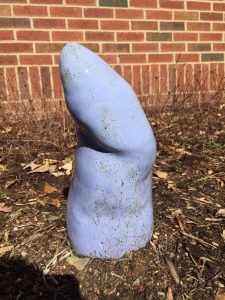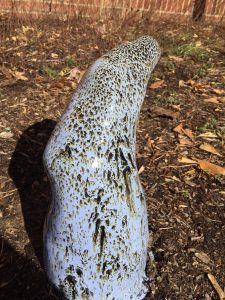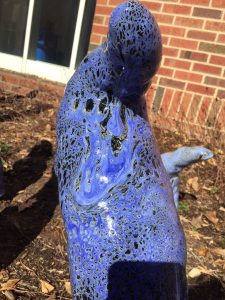(Disclaimer: First of all, I definitely blanked and did not go to the Ackland when I intended to on Sunday. And while I could’ve tried to fudge an analysis using their archives online, that seemed so lame and not in the spirit of this class. So on Monday I walked to the Hanes Art Center and spent some time with the “purple tendrils” outside our classroom.)
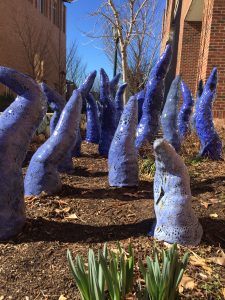
The title plaque reads:
Each Season Unlike the Last
2017
At first glance, there are 3D sculptures that look like little octopus tentacles coming out of the ground, spanning 30 feet, near one of the entrances of the Hanes Art Center. There’s 53 of them of varying heights. One might say they are pretty large for ceramic sculpture and I think they must have been molded by hand, not thrown on the wheel. Their size and the variance of their shapes is what give me that impression. The shortest are almost a foot, the tallest about 3 feet. They look smooth and shiny and they are glazed. Despite a slight variance in color, it appears they were all glazed the same wy – A periwinkle purple and blue hue on top of a darker black glaze. I assume the black glaze is underneath because of the way the purple pools around it. I especially like the larger tendrils that have purple glaze dripping off of it, frozen mid-drip. The smallest pieces tend to be a lighter purple than the tallest pieces and some barely have any black spot at all. This might be due to the amount of time they were fired – more black means fired longer, less black fired for less time. Though the size and color difference, there a definite uniformity to all 53 tendrils.
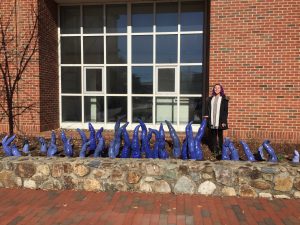
I wonder if they are hollow – I’d assume yes, from what I know about clay and how long it takes to dry. But they must also be thick enough to ensure they didn’t collapse before they were dried and fired. The title “Each Season Unlike the Last” implies, to me, a passage of time. There’s a lot of movement in this piece and all the tentacles, from left to right, show a progression of height. Tallest in the middle, shortest on the sides. While this piece does not have a utilitarian purpose, the tendrils needed to have the ability to withstand the elements of the outdoors. I love how they are buried in the dirt and I wonder how they stay upright. Maybe some employ a metal rod to add stability in some of the tallest ones, or, perhaps, simply their weight is enough to keep them standing. Some of the tendrils are coming unburied and you can see the small lip that is meant to be under the dirt. While they do look like octopus tentacles, I think they’re just organic forms that move along with you as you walk past. And while they gave me sea monster vibes at first, there’s nothing creepy about them to me. They seem docile and peaceful, and they are a natural addition to Hanes’ landscape.
